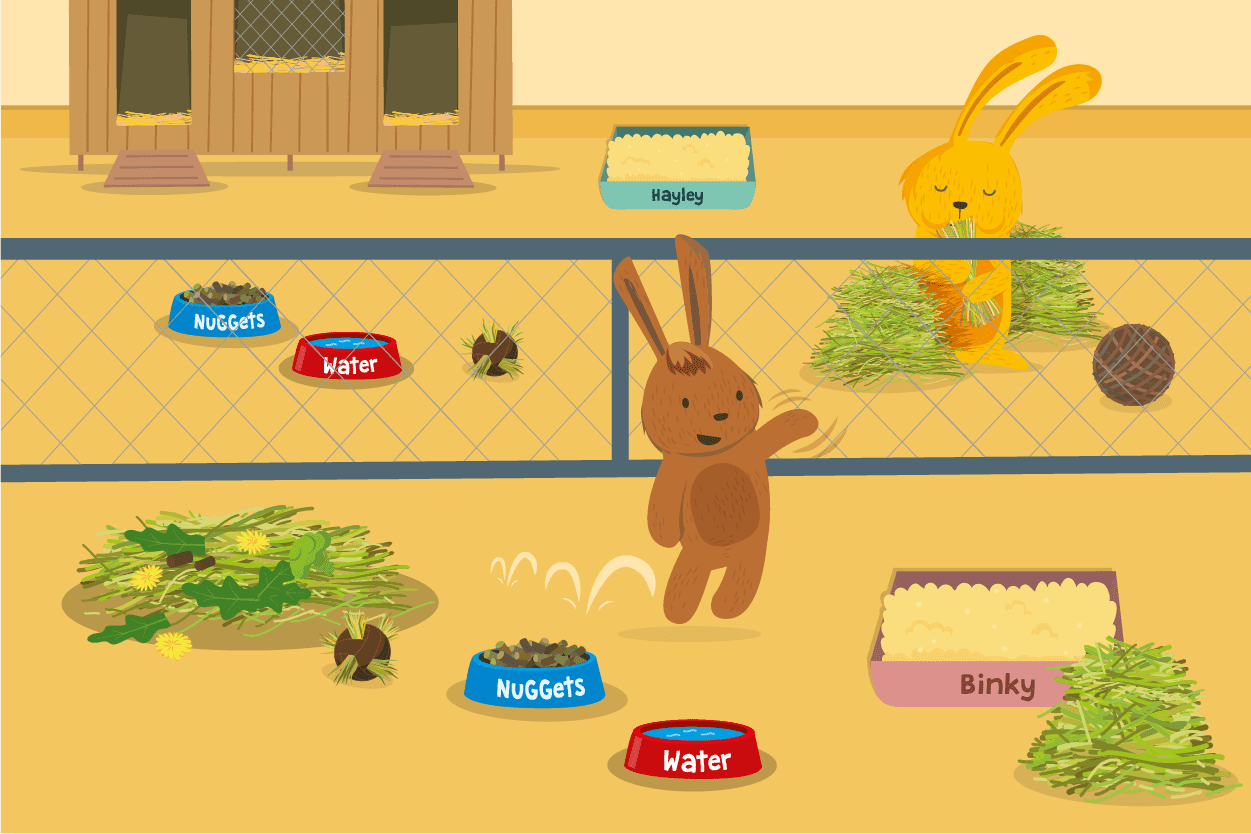Indoor Rabbit Housing
Caring for indoor rabbits:
Creating a great indoor rabbit house
Rabbits can happily live indoors or outdoors. The trick to indoor housing is adapting their environment for the great indoors. Get this right, and you’ll have a lovely experience with your fluffy housemates. Take a look at our top tips for your rabbits’ indoor set up.
Location, location, location: Where will your rabbits live in your home?
Free roam
A full room
Part of a room

Have you got enough space for your rabbits?
The minimum recommended space for a pair of bonded rabbits is 3m x 2m x 1m high. This applies to indoor and outdoor rabbits. To create your rabbits indoor set up, you can use items like large rabbit runs, or dog crates/puppy pens. Your rabbits need plenty of space to exercise, explore, and play.
Plus, they’ll need space to include everything they need! Items to include in your rabbits’ indoor home include:
- Hay racks
- Water bowls
- Hiding places, for example, Runaround tunnel and snugs
- Tunnels
- Platforms
- Litter tray
- Digging box
- Rabbit toys and boredom breakers
- Separate sleeping and toileting areas
For more information on the rabbit housing essentials, see our welfare page.

Rabbit proofing your home
Keeping your rabbits safe in their housing is vital. Indoor rabbits will face different hazards than their outdoor counterparts. Things to watch out for include:
- Electrical wires
- Skirting boards and doors
- House plants
- Slippy flooring
- Escape routes
Rabbits love to chew. It’s a natural behaviour and something that should be encouraged. Chewing helps to wear down their ever growing teeth, which helps to prevent dental problems. The problem is our rabbits don’t know what they can chew and what they can’t! This is why we need to make sure their indoor housing is chew proof.
Are there any escape routes?
Rabbits are curious animals and will want to explore their surroundings. However, if you are keeping your rabbits in one indoor area, like a room, or section of a room, it’s important that they stay in their rabbit proofed space.
Rabbits can squeeze through very small spaces, so equipment like baby gates are great to use in supervised time, but may not be suitable once they are on their own - especially if you have smaller rabbits. Rabbits can also jump up between two and four feet high! So any gates also need to be high enough to be jump proof.
House plants
RWAF advises to treat all house plants as if they are poisonous. With so many varieties, it is hard to confirm the status of each and every one. Instead, keep them well out of reach (remember rabbits can jump), or out of the room your rabbits live in.
A place to poo: house training your rabbits
In the wild, rabbits will experience natural materials underfoot. Soil, grass, moss all give great grip for their feet. Therefore, we need to try to replicate this at home. The fur on rabbits’ feet doesn’t give them much grip, or protection against hard, slippy flooring. Make sure to put down mats on hard floors. Items like soft door mats or bath mats are great choices.
Electrical Wires
The Rabbit Welfare Association & Fund states, “In the wild, while burrowing, rabbits chew through roots and they will treat wires in the same way.” This means any wires need to be safely tucked away. Cable protectors or covers are easy ways to hide wires from rabbit teeth. Alternatively, where possible you can secure wires high up on the walls, out of reach of your rabbits.
Skirting boards, doors, and furniture
Indoor rabbit flooring
You can make your rabbits’ indoor housing much easier to clean by litter training your bunnies. This will be particularly helpful if you choose to have free roam buns!
Give your rabbits some privacy with their toileting area. Place their litter tray out of the way and add a non-slip matt to help your rabbit in and out. Rabbits love to poo and chew. Adding a hay rack within reach is a great idea to encourage your rabbits to keep eating their high fibre hay. When you change their litter tray, pop a small amount of droppings and soiled material back in to encourage them to reuse it. For litter material, use a non-clumping bedding, or newspaper and hay.

Did you know? Neutered rabbits are generally easier to litter train.

Make sure you fulfill the rest of their rabbit welfare needs
The key to a happy and healthy life for our rabbits is that all of their five welfare needs are met. These are:
- Environment: Create a great indoor set up
- Diet: Being fed a diet that’s 85-90% feeding hay or fresh grass, 5% commercial nuggets, 10% fresh greens, the occasional healthy snack, and constant access to fresh, clean water
- Companionship: Rabbits are social animals that should be kept in suitable bonded pairs or small groups
- Behaviour: The ability to display their natural behaviours with plenty of enrichment activities
- Health: Leading a healthy life, with access to suitable veterinary care, including their yearly vaccinations




